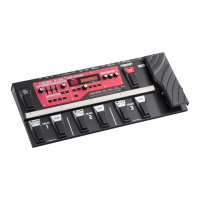Why can't I record or overdub on my Boss Audio Systems Boss Loop Station RC-300?
- CcaldwellcynthiaSep 6, 2025
You cannot record/overdub to tracks set to ONE SHOT. If you want to record/overdub, change the Play Mode setting to LOOP.

Why can't I record or overdub on my Boss Audio Systems Boss Loop Station RC-300?
You cannot record/overdub to tracks set to ONE SHOT. If you want to record/overdub, change the Play Mode setting to LOOP.
What should I do if my Boss Audio Systems Boss Loop Station RC-300 displays 'Data Damaged!'?
If your Boss Audio Systems Music Pedal displays 'Data Damaged!', execute Factory Reset to restore the RC-300 to its factory default condition. This issue may arise if an invalid file was written while connected in USB mass storage mode, or if the 'BOSS_RC-300' drive was formatted using a computer.
How to resolve 'MIDI Error!' on Boss Audio Systems Boss Loop Station RC-300 Music Pedal?
To address a 'MIDI Error!' on your Boss Audio Systems Music Pedal, check to make sure that no corrupt MIDI messages are being transmitted and reduce the number or size of MIDI messages transmitted to the RC-300.
How do I fix 'Not Empty!' error on Boss Audio Systems Boss Loop Station RC-300?
If you receive a 'Not Empty!' error when saving a phrase memory on your Boss Audio Systems Music Pedal, it means you’re trying to overwrite a phrase memory in which data was already saved. Select an empty phrase memory, and then save.
What does 'Event Full!' mean on my Boss Audio Systems Boss Loop Station RC-300 and how to fix it?
If your Boss Audio Systems Music Pedal displays 'Event Full!', it means further overdubbing is not possible. To resolve this, re-save the phrase.
What does 'Buffer Full!' mean on Boss Audio Systems Music Pedal and how to resolve it?
A 'Buffer Full!' message on the RC-300 indicates that an excessive volume of messages were received and could not be processed properly. Decrease the amount of MIDI messages that are being sent to the RC-300.
| Model | RC-300 |
|---|---|
| Manufacturer | Boss Audio Systems |
| Type | Loop Station |
| Number of Tracks | 3 |
| Maximum Recording Time | Up to 3 hours |
| USB Connectivity | Yes |
| Sampling Frequency | 44.1 kHz |
| A/D Conversion | 24-bit |
| D/A Conversion | 24-bit |
| Inputs | 1 x 1/4" (aux) |
| Outputs | 2 x 1/4" (L/Mono, R) |
| Power Source | AC adapter (included) |
Provides a detailed overview of the RC-300's top panel controls, including MASTER, TRACK, and RHYTHM sections.
Explains the various input and output jacks on the rear panel of the RC-300, including USB and MIDI.
Explains how the RC-300 is organized, including tracks, phrase memories, rhythms, and LOOP FX.
Guides users on selecting phrase memories, recording, overdubbing, and basic playback.
Details track stopping, undo/redo functionality, and clearing tracks for efficient performance.
Explains how to save phrase memories and copy tracks between them.
Covers exchanging the order of phrase memories and deleting them to initialize settings.
Details track playback modes, tempo synchronization, measure specifications, and reverse playback options.
Covers naming, volume, tempo settings, and recording modes for phrase memories.
Explains sounding rhythms, setting tempo, selecting patterns/beats, and configuring count-in/stop settings.
Guides users on turning LOOP FX on/off, controlling effects, and selecting FX categories and types.
Covers display contrast, pedal operations, auto record, MIDI, and USB settings for overall device configuration.
Describes USB mass storage for file transfer and USB audio for computer sound playback/recording.
Introduces MIDI, details RC-300 MIDI settings, and explains synchronizing two RC-300 units.
Addresses common issues with sound, operation, MIDI, and USB connectivity.
Provides essential safety guidelines for operating, maintaining, and handling the RC-300 unit.
Lists detailed technical specifications and regulatory compliance information for the RC-300.
